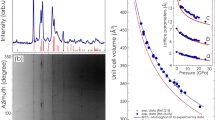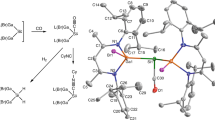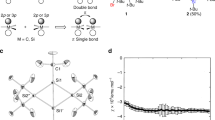Abstract
Perfluorarylborane Lewis acids catalyse the addition of silicon–hydrogen bonds across C=C, C=N and C=O double bonds. This ‘metal-free’ hydrosilylation has been proposed to occur via borane activation of the silane Si–H bond, rather than through classical Lewis acid/base adducts with the substrate. However, the key borane/silane adduct had not been observed experimentally. Here it is shown that the strongly Lewis acidic, antiaromatic 1,2,3-tris(pentafluorophenyl)-4,5,6,7-tetrafluoro-1-boraindene forms an observable, isolable adduct with triethylsilane. The equilibrium for adduct formation was studied quantitatively through variable-temperature NMR spectroscopic investigations. The interaction of the silane with the borane occurs through the Si–H bond, as evidenced by trends in the Si–H coupling constant and the infrared stretching frequency of the Si–H bond, as well as by X-ray crystallography and theoretical calculations. The adduct's reactivity with nucleophiles demonstrates conclusively the role of this species in metal-free ‘frustrated-Lewis-pair’ hydrosilylation reactions.
This is a preview of subscription content, access via your institution
Access options
Subscribe to this journal
Receive 12 print issues and online access
$259.00 per year
only $21.58 per issue
Buy this article
- Purchase on Springer Link
- Instant access to full article PDF
Prices may be subject to local taxes which are calculated during checkout





Similar content being viewed by others
References
Hartwig, J. F. Organotransition Metal Chemistry—From Bonding to Catalysis. (Univ. Science Books, 2010).
Bullock, R. M. Abundant metals give precious hydrogenation performance. Science 342, 1054–1055 (2013).
Frey, G. D., Lavallo, V., Donnadieu, B., Schoeller, W. W. & Bertrand, G. Facile splitting of hydrogen and ammonia by nucleophilic activation at a single carbon center. Science 316, 439–441 (2007).
Welch, G. C., Juan, R. R. S., Masuda, J. D. & Stephan, D. W. Reversible, metal-free hydrogen activation. Science 314, 1124–1126 (2006).
Spikes, G. H., Fettinger, J. C. & Power, P. P. Facile activation of dihydrogen by an unsaturated heavier main group compound. J. Am. Chem. Soc. 127, 12232–12233 (2005).
Massey, A. G., Park, A. J. & Stone, F. G. A. Tris(pentafluorophenyl)boron. Proc. Chem. Soc. 212 (1963).
Parks, D. J. & Piers, W. E. Tris(pentafluorophenyl)boron-catalyzed hydrosilation of aromatic aldehydes, ketones, and esters. J. Am. Chem. Soc. 118, 9440–9441 (1996).
Blackwell, J. M., Sonmor, E. R., Scoccitti, T. & Piers, W. E. B(C6F5)3-catalyzed hydrosilation of imines via silyliminium intermediates. Org. Lett. 2, 3921–3923 (2000).
Rubin, M., Schwier, T. & Gevorgyan, V. Highly efficient B(C6F5)3-catalyzed hydrosilylation of olefins. J. Org. Chem. 67, 1936–1940 (2002).
Blackwell, J. M., Morrison, D. J. & Piers, W. E. B(C6F5)3-catalyzed hydrosilation of enones and silyl enol ethers. Tetrahedron 58, 8247–8254 (2002).
Berkefeld, A., Piers, W. E. & Parvez, M. Tandem frustrated Lewis pair/tris(pentafluorophenyl)borane-catalyzed deoxygenative hydrosilylation of carbon dioxide. J. Am. Chem. Soc. 132, 10660–10661 (2010).
Müther, K., Mohr, J. & Oestreich, M. Silylium ion promoted reduction of imines with hydrosilanes. Organometallics 32, 6643–6646 (2013).
Chen, D., Leich, V., Pan, F. & Klankermayer, J. Enantioselective hydrosilylation with chiral frustrated Lewis pairs. Chem. Eur. J. 18, 5184–5187 (2012).
Chase, P. A., Welch, G. C., Jurca, T. & Stephan, D. W. Metal-free catalytic hydrogenation. Angew. Chem. Int. Ed. 46, 8050–8053 (2007).
Chase, P. A., Jurca, T. & Stephan, D. W. Lewis acid-catalyzed hydrogenation: B(C6F5)3-mediated reduction of imines and nitriles with H2 . Chem. Commun. 1701–1703 (2008).
Chernichenko, K. et al. A frustrated-Lewis-pair approach to catalytic reduction of alkynes to cis-alkenes. Nature Chem. 5, 718–723 (2013).
Parks, D. J., Piers, W. E., Parvez, M., Atencio, R. & Zaworotko, M. J. Synthesis and solution and solid-state structures of tris(pentafluorophenyl)borane adducts of PhC(O)X (X=H, Me, OEt, NPr2i). Organometallics 17, 1369–1377 (1998).
Blackwell, J. M., Piers, W. E., Parvez, M. & McDonald, R. Solution and solid-state characteristics of imine adducts with tris(pentafluorophenyl)borane. Organometallics 21, 1400–1407 (2002).
Parks, D. J., Blackwell, J. M. & Piers, W. E. Studies on the mechanism of B(C6F5)3-catalyzed hydrosilation of carbonyl functions. J. Org. Chem. 65, 3090–3098 (2000).
Stephan, D. W. ‘Frustrated Lewis pairs’; a concept for new reactivity and catalysis. Org. Biomol. Chem. 6, 1535–1539 (2008).
Stephan, D. W. & Erker, G. Frustrated Lewis pairs: metal-free hydrogen activation and more. Angew. Chem. Int. Ed. 49, 46–76 (2010).
Rokob, T. A., Hamza, A., Stirling, A. & Pápai, I. On the mechanism of B(C6F5)3-catalyzed direct hydrogenation of imines: inherent and thermally induced frustration. J. Am. Chem. Soc. 131, 2029–2036 (2009).
Piers, W. E., Marwitz, A. J. V. & Mercier, L. G. Mechanistic aspects of bond activation with perfluoroarylboranes. Inorg. Chem. 50, 12252–12262 (2011).
Grimme, S., Kruse, H., Goerigk, L. & Erker, G. The mechanism of dihydrogen activation by frustrated Lewis pairs revisited. Angew. Chem. Int. Ed. 49, 1402–1405 (2010).
Rokob, T. A., Bakó, I., Stirling, A., Hamza, A. & Pápai, I. Reactivity models of hydrogen activation by frustrated Lewis pairs: synergistic electron transfers or polarization by electric field? J. Am. Chem. Soc. 135, 4425–4437 (2013).
Sakata, K. & Fujimoto, H. Quantum chemical study of B(C6F5)3-catalyzed hydrosilylation of carbonyl group. J. Org. Chem. 78, 12505–12512 (2013).
Rendler, S. & Oestreich, M. Conclusive evidence for an SN2–Si mechanism in the B(C6F5)3-catalyzed hydrosilylation of carbonyl compounds: implications for the related hydrogenation. Angew. Chem. Int. Ed. 47, 5997–6000 (2008).
Hog, D. T. & Oestreich, M. B(C6F5)3-catalyzed reduction of ketones and imines using silicon-stereogenic silanes: stereoinduction by single-point binding. Eur. J. Org. Chem. 2009, 5047–5056 (2009).
Hermeke, J., Mewald, M. & Oestreich, M. Experimental analysis of the catalytic cycle of the borane-promoted imine reduction with hydrosilanes: spectroscopic detection of unexpected intermediates and a refined mechanism. J. Am. Chem. Soc. 135, 17537–17546 (2013).
Marwitz, A. J. V., Dutton, J. L., Mercier, L. G. & Piers, W. E. Dihydrogen activation with tBu3P/B(C6F5)3: a chemically competent indirect mechanism via in situ generated p-tBu2P–C6F4–B(C6F5)2 . J. Am. Chem. Soc. 133, 10026–10029 (2011).
Parks, D. J., Piers, W. E. & Yap, G. P. A. Synthesis, properties, and hydroboration activity of the highly electrophilic borane bis(pentafluorophenyl)borane, HB(C6F5)2 . Organometallics 17, 5492–5503 (1998).
Nikonov, G. I., Vyboishchikov, S. F. & Shirobokov, O. G. Facile activation of H–H and Si–H bonds by boranes. J. Am. Chem. Soc. 134, 5488–5491 (2012).
Parks, D. J., von H. Spence, R. E. & Piers, W. E. Bis(pentafluorophenyl)borane: synthesis, properties, and hydroboration chemistry of a highly electrophilic borane reagent. Angew. Chem. Int. Ed. Engl. 34, 809–811 (1995).
Chojnowski, J. et al. Mechanism of the B(C6F5)3-catalyzed reaction of silyl hydrides with alkoxysilanes. Kinetic and spectroscopic studies. Organometallics 24, 6077–6084 (2005).
Jiang, Y. et al. The ‘catalytic nitrosyl effect’: NO bending boosting the efficiency of rhenium based alkene hydrogenations. J. Am. Chem. Soc. 135, 4088–4102 (2013).
Bergquist, C. et al. Aqua, alcohol, and acetonitrile adducts of tris(perfluorophenyl)borane: evaluation of Brønsted acidity and ligand lability with experimental and computational methods. J. Am. Chem. Soc. 122, 10581–10590 (2000).
Beringhelli, T., Maggioni, D. & D'Alfonso, G. 1H and 19F NMR investigation of the reaction of B(C6F5)3 with water in toluene solution. Organometallics 20, 4927–4938 (2001).
Blackwell, J. M., Foster, K. L., Beck, V. H. & Piers, W. E. B(C6F5)3-catalyzed silation of alcohols: a mild, general method for synthesis of silyl ethers. J. Org. Chem. 64, 4887–4892 (1999).
Gevorgyan, V., Rubin, M., Benson, S., Liu, J-X. & Yamamoto, Y. A novel B(C6F5)3-catalyzed reduction of alcohols and cleavage of aryl and alkyl ethers with hydrosilanes. J. Org. Chem. 65, 6179–6186 (2000).
Richter, D., Tan, Y., Antipova, A., Zhu, X-Q. & Mayr, H. Kinetics of hydride abstractions from 2-arylbenzimidazolines. Chem. Asian J. 4, 1824–1829 (2009).
Fan, C., Piers, W. E. & Parvez, M. Perfluoropentaphenylborole. Angew. Chem. Int. Ed. 48, 2955–2958 (2009).
Fukazawa, A. et al. Reaction of pentaarylboroles with carbon monoxide: an isolable organoboron carbonyl complex. Chem. Sci. 3, 1814–1818 (2012).
Fan, C., Mercier, L. G., Piers, W. E., Tuononen, H. M. & Parvez, M. Dihydrogen activation by antiaromatic pentaarylboroles. J. Am. Chem. Soc. 132, 9604–9606 (2010).
Houghton, A. Y., Karttunen, V. A., Fan, C., Piers, W. E. & Tuononen, H. M. Mechanistic studies on the metal-free activation of dihydrogen by antiaromatic pentarylboroles. J. Am. Chem. Soc. 135, 941–947 (2012).
Braunschweig, H., Damme, A., Hörl, C., Kupfer, T. & Wahler, J. Si–H bond activation at the boron center of pentaphenylborole. Organometallics 32, 6800–6803 (2013).
Houghton, A. Y., Karttunen, V. A., Piers, W. E. & Tuononen, H. M. Hydrogen activation with perfluorinated organoboranes: 1,2,3-tris(pentafluorophenyl)-4,5,6,7-tetrafluoro-1-boraindene. Chem. Commun. 50, 1295–1298 (2014).
Corey, J. Y. & Braddock-Wilking, J. Reactions of hydrosilanes with transition-metal complexes: formation of stable transition-metal silyl compounds. Chem. Rev. 99, 175–292 (1998).
Nava, M. & Reed, C. A. Triethylsilyl perfluoro-tetraphenylborate, [Et3Si+][F20-BPh4−], a widely used nonexistent compound. Organometallics 30, 4798–4800 (2011).
Berkefeld, A. et al. Carbon monoxide activation via O-bound CO using decamethylscandocinium–hydridoborate ion pairs. J. Am. Chem. Soc. 134, 10843–10851 (2012).
Bader, R. F. W. Atoms in Molecules: A Quantum Theory (Oxford Univ. Press, 1990).
Wrackmeyer, B., Milius, W. & Tok, O. L. Reaction of alkyn-1-yl(diorganyl)silanes with 1-boraadamantane: Si–H–B bridges confirmed by the molecular structure in the solid state and in solution. Chem. Eur. J. 9, 4732–4738 (2003).
Acknowledgements
Funding for the experimental work described was provided by the Natural Sciences and Engineering Research Council of Canada in the form of a Discovery Grant to W.E.P. Funding for the computational work described was provided by the Academy of Finland in the form of a Research Grant and Fellowship to H.M.T.
Author information
Authors and Affiliations
Contributions
A.Y.H. and W.E.P. conceived and designed the experiments, A.Y.H. performed the experiments and determined the X-ray structure, H.M.T. and A.M. conceived and designed the computational work, J.H. and A.M. executed the calculations and performed data analyses. A.Y.H., W.E.P. and A.M. co-wrote the paper with input from J.H. and H.M.T.
Corresponding authors
Ethics declarations
Competing interests
The authors declare no competing financial interests.
Supplementary information
Supplementary information
Supplementary information (PDF 3789 kb)
Supplementary information
Crystallographic data for compound 2 (CIF 24 kb)
Rights and permissions
About this article
Cite this article
Houghton, A., Hurmalainen, J., Mansikkamäki, A. et al. Direct observation of a borane–silane complex involved in frustrated Lewis-pair-mediated hydrosilylations. Nature Chem 6, 983–988 (2014). https://doi.org/10.1038/nchem.2063
Received:
Accepted:
Published:
Issue Date:
DOI: https://doi.org/10.1038/nchem.2063
This article is cited by
-
Late-stage chemoselective functional-group manipulation of bioactive natural products with super-electrophilic silylium ions
Nature Chemistry (2018)
-
Borane catalysed ring opening and closing cascades of furans leading to silicon functionalized synthetic intermediates
Nature Communications (2016)
-
Formal SiH4 chemistry using stable and easy-to-handle surrogates
Nature Chemistry (2015)
-
Chemoselective conversion of biologically sourced polyols into chiral synthons
Nature Chemistry (2015)
-
Molecular editing of carbohydrates
Nature Chemistry (2015)



